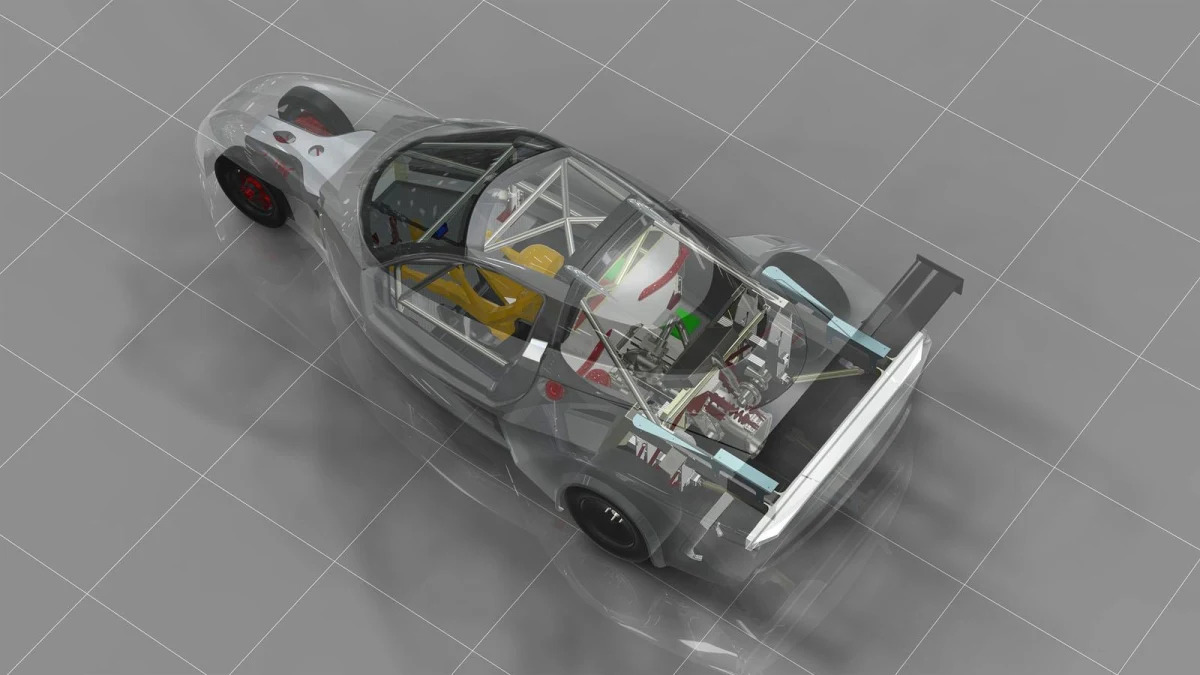Don Panoz has been nothing if not ambitious with his DeltaWing project, and now he's targeting another milestone: to field a completely electric-powered prototype at Le Mans.
The project, which is reportedly already six months into development, is a further evolution of the revolutionary DeltaWing design we've already seen. It puts two small wheels spaced closely together at the front, with a wider track at the rear, offering numerous packaging and aerodynamic advantages over conventional setups.
After an initial proposal was rejected by the IndyCar Series, the DeltaWing team fielded a repackaged version at Le Mans and other endurance races. It was initially supported by Nissan, which subsequently withdrew from the program to launch its own ZEOD RC (Zero Emissions On Demand Racing Car). The hybrid prototype featured a similar design, and while it didn't manage to complete the entire race distance at Le Mans last year, it did achieve its goal of completing a full lap of the circuit under electric power alone.
Both the DeltaWing and the Nissan ZEOD RC competed as Garage 56 entries, a slot reserved by the Automobile Club de l'Ouest (the organizers of the 24 Hours of Le Mans) for experimental vehicles. Now it seems Panoz and DeltaWing are after that same slot, but based on the DeltaWing GT design, and under pure electric power, without an internal combustion engine like the ZEOD and other hybrid prototypes use.
Now, if you're thinking that the battery technology isn't there yet to allow an electric prototype to race for 24 hours on a single charge, you're right. And Panoz doesn't expect to rely on rapid charging technology to quickly fill the cells, or swap cars like they do in Formula E, either: DeltaWing is reportedly working on a swappable battery system, ostensibly similar to what Better Place pioneered.
The system would allow the vehicle to run for 50 minutes before stopping to swap power packs in the same amount of time it would take a conventionally-powered racer to refuel. Only that would mean the car would need to stop at least 29 times over the course of the race. In between swap-stops, however, the DeltaWing EV would potentially lap the circuit as fast as a modern GTE car. Those weigh over 2,200 pounds, and Panoz's prototype is targeted to weigh around 1,500-1,600 pounds, so they'd be able to fit more batteries in to make up the weight and last longer.
Panoz calls his target the "Holy Grail," and he ought to know. Aside from founding the American Le Mans Series and heading up the DeltaWing project, he fielded the first hybrid prototype at Le Mans with the Reynard Q9 way back in 1998, long before the likes of Audi, Porsche, Peugeot, and Toyota would field hybrid-powered LMP1 prototypes of their own.
The project, which is reportedly already six months into development, is a further evolution of the revolutionary DeltaWing design we've already seen. It puts two small wheels spaced closely together at the front, with a wider track at the rear, offering numerous packaging and aerodynamic advantages over conventional setups.
After an initial proposal was rejected by the IndyCar Series, the DeltaWing team fielded a repackaged version at Le Mans and other endurance races. It was initially supported by Nissan, which subsequently withdrew from the program to launch its own ZEOD RC (Zero Emissions On Demand Racing Car). The hybrid prototype featured a similar design, and while it didn't manage to complete the entire race distance at Le Mans last year, it did achieve its goal of completing a full lap of the circuit under electric power alone.
Both the DeltaWing and the Nissan ZEOD RC competed as Garage 56 entries, a slot reserved by the Automobile Club de l'Ouest (the organizers of the 24 Hours of Le Mans) for experimental vehicles. Now it seems Panoz and DeltaWing are after that same slot, but based on the DeltaWing GT design, and under pure electric power, without an internal combustion engine like the ZEOD and other hybrid prototypes use.
Now, if you're thinking that the battery technology isn't there yet to allow an electric prototype to race for 24 hours on a single charge, you're right. And Panoz doesn't expect to rely on rapid charging technology to quickly fill the cells, or swap cars like they do in Formula E, either: DeltaWing is reportedly working on a swappable battery system, ostensibly similar to what Better Place pioneered.
The system would allow the vehicle to run for 50 minutes before stopping to swap power packs in the same amount of time it would take a conventionally-powered racer to refuel. Only that would mean the car would need to stop at least 29 times over the course of the race. In between swap-stops, however, the DeltaWing EV would potentially lap the circuit as fast as a modern GTE car. Those weigh over 2,200 pounds, and Panoz's prototype is targeted to weigh around 1,500-1,600 pounds, so they'd be able to fit more batteries in to make up the weight and last longer.
Panoz calls his target the "Holy Grail," and he ought to know. Aside from founding the American Le Mans Series and heading up the DeltaWing project, he fielded the first hybrid prototype at Le Mans with the Reynard Q9 way back in 1998, long before the likes of Audi, Porsche, Peugeot, and Toyota would field hybrid-powered LMP1 prototypes of their own.






Sign in to post
Please sign in to leave a comment.
Continue